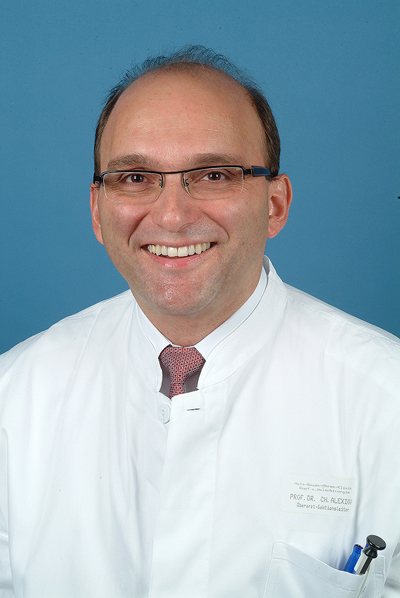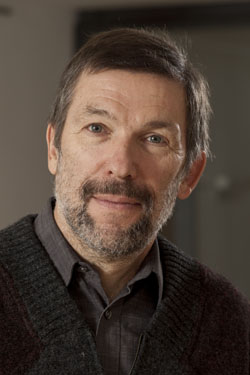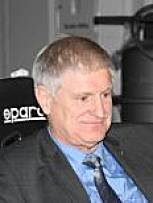Invited Talks
 |
Prof. Dr. Christoph Alexiou Application of Magnetic Nanoparticles (SPION) in Medicine – The SEON-Concept Prof. Alexiou leads the interdisciplinary Section of Experimental Oncology and Nanomedicine (SEON). In his invited talk, he will show the broad spectrum of magnetic nanoparticles (SPION) concerning their use in medicine, with a special focus on drug delivery in oncology and their promising potential applications in cardiovascular and regenerative medicine. The aim of his studies is the translation of the pre-clinical results into clinical trials: He will introduce the SEON-concept, which addresses the respective steps necessary to gain this ambitious object.
|
|
.jpg) |
Julian Carrey, Ph.D. Magnetic Hyperthermia from the Physics Side : State of the Art and Open Questions Dr. Carrey studies the magnetotransport and magnetic hyperthermia properties of nanoparticles prepared by organometallic chemistry. In this invited talk, he will comprehensively update us on the newest theoretical aspects around magnetic hyperthermia and illustrate them with experimental results. He will also show some unique unconventional hyperthermia setups that are used to investigate magnetic hyperthermia effects. Furthermore, recent literature results will be discussed where no temperature rise was seen and where surface temperatures are measured and discussed. |
|
.jpg) |
Joachim Clement, Ph.D. Tumour Biology and Nanomaterials Group, Dept. Hematology and Oncology, University Hospital, Jena, Friedrich Schiller University, Jena, Germany Tutorial on “Biology for the Physicist, Chemist and Engineer” We had now several tutorials about the basic magnetism of particles, but never about the biological side of things. With Dr. Clement's three half-hour lectures, we plan to change that and turn you all into small biologists! This series of lectures will include what happens when a magnetic (nano)particles enters the body and where it ends up (biodistribution), aspects of particle toxicity and how that can be tested in cells (in vitro) and in animals (in vivo). Dr. Clement will also tell us about how to try to get nanoparticles to the right spot, how to figure out if it worked, and much more. We are sure you will all appreciate this information in your future particle work. You can download Dr. Clement's tutorial here or in our "Resources" section, where you will find other interesting tutorials and basic information. |
|
 |
Prof. Dr. Dieter Scharnweber Engineering cellular microenvironments – chemistry meets physics Prof. Scharnweber takes an engineering approach in developing strategies to mimic both the biochemical and physical properties of native cellular microenvironment. His talk will focus on aspects of matrix engineering with glycosaminoglycan derivatives: on how their structure determines their interaction with proteins, on how they can direct stem cells fate in combinations of biochemical and physical signals, and on the potential applications of magnetic nanoparticles in such signal combinations. |
|
 |
Prof. Dr. Annette M. Schmidt Responsive Core-Shell Nanoparticles for Medical Applications The convergence of responsive organic moieties with magnetic nanosized objects offers various application perceptions in the biomedical area as therapeutic or diagnostic agents. The talk will summarize recent developments with respect to site-specific or on-demand activity of nanoscopic magnetic carriers with a focus on biocatalytic systems and the delivery of bioactive small molecules. Combining concepts from polymer and colloid chemistry and material science, we are engaged in the development of novel perspectives to get organic-inorganic hybrid nanostructures into biological interaction. |
|
 |
Prof. Dr. Ludwig Schultz
New means of urban transportation and logistics will become realistic with superconducting magnetic bearings using nanostructured bulk high temperature superconductors. The advantage of superconducting magnetic levitation is that it works passively stable without any electronic control but with attracting and repelling forces to suspend a vehicle pendant or standing upright from zero to high speed - perfect conditions for the idea of rail-bound individual transport with cabins for 4 - 5 passengers requested call by call.
|
|
.jpg) |
Viola Vogel, Ph.D. Professor, Laboratory of Applied Mechanobiology, Department of Health Sciences and Technology, ETH Zurich, Switzerland Nanomechanics by Which Immune Cells Pick Up Their Prey Prof. Vogel deciphers the mechanisms how bacteria and cells sense mechanical stimuli and convert them into biochemical signals that can switch cell functions. This includes asking how bacteria and cells employ the stretching of proteins to switch biochemical functions (mechano-chemical signal conversion), and how such insights can be exploited for biomedical applications. And who knows, maybe we can do the stretching and switching in the future with magnetic (nano)forces! |
|

